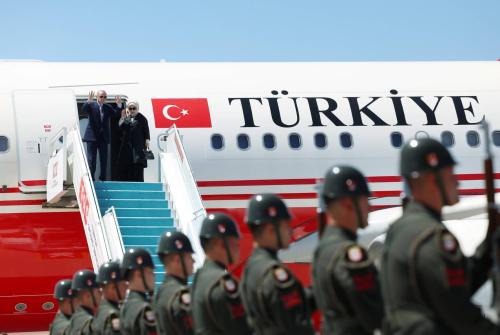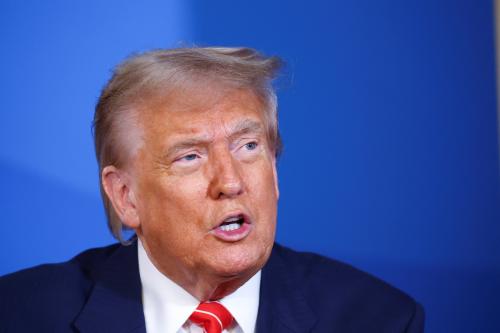Is Saddam going to get the bomb, or isn’t he? As links between the Iraqi tyrant and al-Qaida have proved less than compelling, the Bush administration has increasingly tied its case for “regime change” in Iraq to the argument that Saddam Hussein is again trying to develop nuclear weapons. Skeptics in turn have asked for hard evidence that Saddam really is close to having a nuclear device.
This focus on the nuclear question makes sense. Saddam continues to have chemical weapons in abundance and probably biological agents as well, but we have already proved we can deter him from using these weapons over the past dozen years, and there is no reason to think he has transferred either type to al-Qaida. By contrast, a nuclear weapon is something Saddam almost surely does not now have, but that he might someday acquire—and that, if ever used, could clearly dwarf 9/11 in its effects. We don’t know if Saddam would use or threaten to use nuclear weapons if he had them. But to paraphrase Kenneth Pollack of the Council on Foreign Relations, letting Saddam get a nuclear weapon and then seeing what if anything he might do with it is a social science experiment we can live without. Simply having such a weapon could give Saddam “defensive cover” for aggression, fundamentally changing the balance of power in the region.
That, in a nutshell, is the case for a pre-emptive war. Whatever one thinks of this case, it should not depend on advocates producing a “smoking gun.” Evidence that Saddam is on the verge of building a bomb is unlikely to exist, not only because our sources of intelligence inside Iraq are highly imperfect, but because Iraq is probably still years away from any kind of nuclear capability. Indeed, in his Aug. 26 speech of this year, the only concrete evidence Dick Cheney gave of Iraq’s progress toward a bomb dated back to 1995, and the United Nations has conducted numerous nuclear-related inspections in Iraq since that time. But Saddam is trying to get the bomb. And if that’s a persuasive reason for going to war—as it probably is, in the absence of rigorous inspections that would prevent him from acquiring one—it would make more sense to fight before he had the bomb than after.
However, it’s not necessarily an argument for mounting a full-scale invasion now. That argument depends on how close Saddam really is to obtaining a bomb. So, what do we actually know about Saddam’s nuclear program? The history of U.N. weapons inspections in Iraq, the testimony of defectors like former chief bomb designer Khidhir Hamza, and more recent U.S. intelligence do create a basic picture of Iraq’s nuclear weapons program.
As is well known, Iraq was disturbingly close—perhaps only months away—from building a nuclear weapon at the time of Desert Storm. After Israel bombed its Osirak nuclear reactor a decade earlier, Iraq had embarked on a program to develop less visible technologies for enriching uranium from domestic and possibly foreign sources—its “basement bomb” project. In numerous ways, this effort resembled the difficult and tedious approach taken in the 1940s during the Manhattan Project in the United States, particularly the effort to build uranium-235 devices such as the one dropped on Hiroshima. U.N. inspectors found and destroyed most of the equipment believed to have been involved in Iraq’s effort before the Gulf War of 1991.
When Hamza defected a couple of years later, Iraq’s nuclear program was still in a state of dismantlement. That said, Saddam kept together his bomb designer teams, putting them on other projects to ensure their continued availability and proficiency. By the mid-1990s at the latest, he also had a workable design for a bomb that likely would have been effective, if he had been able to get his hands on fissile material. He also had the capability to manufacture most other critical nuclear-weapon components, such as timing devices and properly shaped conventional explosives to compress the fissile material and initiate the explosion.
In recent months, as reported in The New York Times, U.S. intelligence has gotten word of Iraqi efforts to buy key nuclear-related components. In particular, Iraq seems bent on acquiring large numbers of sophisticated aluminum tubes that could be used to build centrifuges. Centrifuges spin uranium at high speeds, gradually separating the lighter U-235 from the heavier and more prevalent U-238 (which is not capable of supporting a chain reaction and hence not usable in a bomb).
This suggests that Saddam has put his nuclear team back on the job. But if these are the components he is still seeking, it suggests that his nuclear program remains in an early stage. Even if Saddam had succeeded in acquiring these tubes, it would have taken months or years to build the centrifuges and then many months to separate out enough U-235 to build even a single bomb.
The other new intelligence on Iraq’s nuclear program comes from overhead photographs of renewed construction at Iraqi sites where nuclear activities have been conducted in the past. Journalists recently taken to visit such sites saw no signs of illicit activity, though they may not know enough to catch subtle indicators (and Iraq controlled their movements to boot). But it still seems unlikely Saddam would put valuable nuclear-related activities inside buildings that we know full well might be associated with a nuclear program—and hence that we might destroy via an airstrike at any time.
More worrisome, perhaps, is that Saddam might get access to U-235 or plutonium on the black market, most likely with Russian criminal elements as the original source. Thankfully, there is no evidence that the nuclear black market has yet involved large quantities of fissile material. But as Secretary Donald Rumsfeld likes to say, we don’t know what we don’t know. Any delay in pre-emption entails some degree of risk—and precisely what degree is hard to estimate.
Saddam probably could not hurt the United States directly with a bomb even if he had one. Even if he overcomes his most serious obstacle by obtaining fissile material on the black market, he would probably be able to build only a few nuclear weapons, and they would be big. That would make it hard to transport such weapons to give to terrorists or his own foreign-based operatives for use against a U.S. city. He might be able to sneak a bomb into Kuwait or another neighboring state with a low-flying aircraft, but the plane might well also get shot down. He probably does not have a missile big enough to carry what would be a fairly primitive and thus large nuclear warhead.
It is possible that Saddam would consider possession of a bomb a “regime survival insurance card” and undertake aggressive behavior as a result. For example, Saddam might try to take Kuwait’s oil field that was the original purported source of contention back in 1990, prior to Iraq’s invasion of Kuwait. Or he might move forces back into Kurdish regions of his own country, aware that our airpower probably could not stop him and that we might be unwilling to risk escalation by moving in ground forces.
These types of worries are real, if not quite the equivalent of Hitler’s demands at Munich, as Bush administration officials have exaggerated in recent weeks. That said, a nuclear-armed Iraq is a serious concern, and we would be vastly better off without one. Even a war skeptic such as me must acknowledge that President Bush has a reasonable case when he describes the risks involved in Iraq’s nuclear program. Rigorous inspections and disarmament would, to my mind, be an acceptable solution. But to get that outcome, we may have to threaten war, and threaten it quite credibly, as events of the past week have suggested.
The Brookings Institution is committed to quality, independence, and impact.
We are supported by a diverse array of funders. In line with our values and policies, each Brookings publication represents the sole views of its author(s).



Commentary
Op-edSaddam’s Bomb: How close is Iraq to having a nuclear weapon?
September 18, 2002